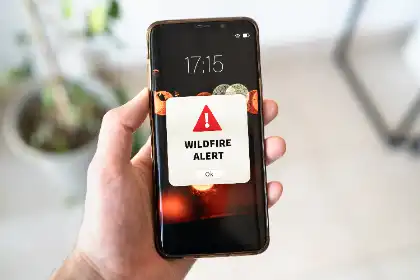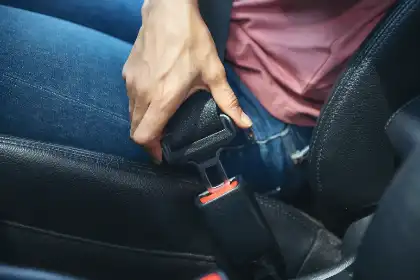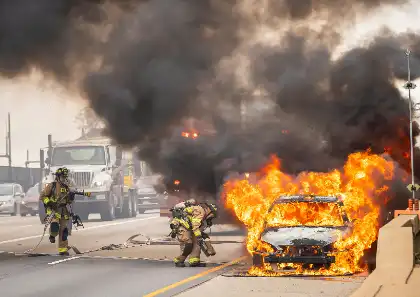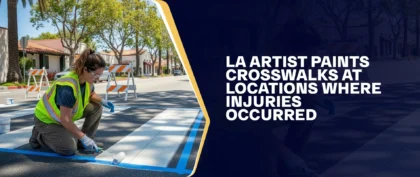Table of Contents
Driving during wildfires can be extremely dangerous. Thick smoke can drastically reduce visibility, rendering even the most familiar routes treacherous. Fallen branches, downed power lines, and other debris can block your path, while encroaching flames can sever escape routes. In extreme scenarios, the intense heat can damage your vehicle, compromising its performance and jeopardizing your safety. Being prepared and staying vigilant are your best defenses in such hazardous conditions.
While many resources emphasize evacuation planning, like packing essentials, gathering family members, and identifying escape routes, there’s limited guidance on what to do if you’re already on the road when wildfires strike. This lack of information can leave drivers vulnerable during rapid-fire emergencies, where every second counts.
Delaying evacuations or underestimating the speed and ferocity of a fire can have dire consequences. It’s imperative to know how to react swiftly and wisely when driving through wildfire zones. Remember, every moment is critical, and having a clear plan can be the difference between safety and catastrophe.
What You Need To Know About Driving Through Wildfires
From 2013 to 2022, an average of 61,410 wildfires occurred annually, burning about 7.2 million acres each year. In 2023 alone, 56,580 wildfires scorched 2.7 million acres and tragically claimed 130 lives. In many of these incidents, evacuation alerts are given to communities near the affected area. Families have to drive out of their homes and stay in evacuation centers or other safe locations until they’re given the signal to return. Driving through areas impacted by wildfires is something no one wants to face, but being prepared can make a life-saving difference.
One of the most immediate dangers when driving through wildfire zones is the thick smoke. Poor visibility can make it nearly impossible to see the car ahead, obstacles, or even the road itself. Additionally, the extreme temperatures from the fire can cause vehicles to overheat, ignite, or, in rare cases, even explode if components fail.
Falling debris is another critical hazard. Burning trees and rocks can quickly block roads and trap drivers and their passengers. In past major wildfires, some evacuees were forced to abandon their vehicles and travel on foot when flames blocked evacuation routes, leaving them stranded.
To help protect yourself and your family, always anticipate potential road closures when traveling through wildfire-prone areas. Carry an emergency kit that includes water, snacks, a first-aid kit, a fire extinguisher, and masks to protect against smoke inhalation. Ensure your vehicle is in optimal working order and familiarize yourself with alternate routes in case of roadblocks. Do your best to stay calm, be vigilant, and prioritize your safety above all else.
Preparing To Drive Safely Through Wildfires
One of the gravest dangers during wildfires is staying in your vehicle and getting trapped, which can lead to serious injuries or even death. The most crucial action you can take is to evacuate as soon as the authorities issue the order. Delaying can significantly limit your escape routes and increase your risk.
Before hitting the road in wildfire zones, it’s crucial to be well-prepared. Here are some essential tips to ensure your safety while driving during wildfires:
Stay Informed
Assess your home and community’s wildfire risk levels. The First Street Foundation offers a tool called Risk Factor, where you can input your address to view data about your area’s potential fire risks. Keep in mind that this tool is for long-term planning and does not provide real-time updates on active events.
Bookmark and be on standby for updates from reliable local resources like:
- Fire.CA.Gov/Incidents offers up-to-date information on active wildfires across California, allowing you to track incidents in progress.
- ReadyForWildfire.org is an excellent resource for wildfire preparation. It covers the three critical stages of readiness:
- READY — Prepare a “go bag” with essential items.
- SET — Be ready to leave at a moment’s notice.
- GO — Immediately evacuate when directed by authorities.
Wildfires can spread rapidly, so it’s vital to stay updated with the latest information. Tune into local news via TV, radio, or online sources, but for the most precise and current details, visit official fire department websites. These sites provide critical updates, including maps of affected areas, road closures, and available shelters.
Pay attention to the fire’s intensity and direction. Wind can propel a fire swiftly, carrying embers that ignite new fires far from the main blaze. Wildfires can even leap across highways and fire barriers, creating new danger zones. If your area is under an evacuation warning, prepare to leave immediately.
Prepare Your Vehicle
When evacuating during wildfires, ensuring your vehicle is properly prepared is crucial. A few essential checks and preparations can make all the difference in reaching safety swiftly and without any issues. Here’s how to get your car ready for the road ahead:
- Keep Your Gas Tank at Least Half Full — In any given situation, always maintain a half-full gas tank. This ensures you won’t need to stop for fuel during an emergency evacuation.
- Check Fluid Levels — Make sure the vehicle’s fluid levels are sufficient, including coolant, windshield washer fluid, brake fluid, power steering fluid, and transmission fluid. Adequate fluid levels can help your car run smoothly.
- Inspect Your Tires — Check your tires for proper air pressure, good tread, and alignment. Worn or improperly inflated tires can make driving more difficult, especially when you’re trying to get to safety quickly.
- Check Your Brakes — Ensure your brakes are in good condition. Worn brakes can produce dangerous sparks that might ignite a fire. Properly maintained brakes are essential for safe driving in an emergency.
- Inspect & Replace Air Filters — When driving during a wildfire, air filters in the car can get clogged with ash and smoke, reducing airflow, which may result in suffocation. Inspect your filters and clean or replace them if necessary to ensure proper air circulation inside your vehicle.
- Clean Your Windows, Mirrors, & Headlights — Clean your windows, mirrors, and headlights to maximize visibility. Always have a cleaning kit on hand in case it is needed.
- Ensure You Have a Fire Extinguisher — Keep a fire extinguisher in your car, within easy reach, and familiarize yourself with its use. It can be a lifesaver in case of an emergency.
Be Prepared Against Health Risks
Driving through wildfire smoke can severely impact your health. While staying indoors is always the safest choice, if you need to drive during wildfires, it’s essential to be prepared to protect yourself against the potential health risks of inhaling smoke. These risks include:
- Chest pain
- Asthma attacks
- Fatigue
- Increased heart rate
- Coughing
- Breathing difficulties
- Headaches
- Eye irritation
To help protect yourself while driving in wildfire conditions, wear a mask to filter out harmful particles. Additionally, ensure your car’s air recirculation is on to minimize exposure to outside smoke. These simple precautions can make a significant difference in safeguarding your health during such hazardous conditions.
Carry An Emergency Kit
When driving through wildfire areas, conditions can change quickly, so it’s important to be ready for anything. Keep an emergency kit in your car with these vital essentials:
- Non-perishable food and water.
- Phone charger, extra batteries, and fully charged power banks.
- A first aid kit and a fire blanket.
- Flashlight with spare batteries.
- Jumper cables and emergency warning lights.
- A physical map (in case you lose cell service).
- Winter supplies (shovel, salt, scraper) if needed.
Also, pack important documents like IDs and insurance papers, along with personal items that have sentimental value, such as photographs, letters, or jewelry. It’s also wise to carry cash for emergencies. Don’t forget to remove any flammable items, like gas cans or oil, from your car to reduce the risk of fire.
In addition to preparing an emergency kit, it’s important to follow the 6 P’s of evacuation to enhance your readiness for an emergency.
Find An Evacuation Shelter
In an emergency, local authorities may open shelters to accommodate evacuees. Before heading to one, check what amenities they offer and any restrictions they might have. For example, while they may provide medical assistance, they might not allow small pets.
If you’re not planning to go to a local shelter, it’s important to have an alternative plan. Inform an out-of-state emergency contact about your route and destination. Additionally, share your evacuation plan and route with a friend or family member so someone knows your whereabouts and can help if needed.
If you do not have any contacts, consider reaching out to local community organizations, neighbors, or emergency services to inform them of your evacuation plans. Many communities have support networks in place to assist residents during emergencies, ensuring that someone is aware of your location and can help if necessary.
Helpful Tip: You can check fire.ca.gov for the latest shelter information, including animal shelters, based on your location. Use your GPS to navigate to the nearest evacuation shelter and stay updated on any route changes or roadblocks.
How To Stay Safe On The Road During Wildfires
Los Angeles, California, is experiencing increasingly destructive wildfires, with many still not under control. As of January 27, 2025, these fires have claimed at least 29 lives and forced more than 150,000 people into mandatory evacuations, according to the Los Angeles Times. While many residents had little time to prepare, experts advise fire zone residents to plan ahead.
Driving through wildfires is a life-threatening situation that demands immediate action and calm decision-making. In such conditions, it’s crucial to stay composed and stay informed about the fire’s direction by monitoring updates from reliable sources.
Stay Aware Of Your Surroundings And Avoid Distractions
Keeping your attention on the road helps prevent accidents and allows you to react to unexpected hazards promptly. Avoid accident-causing distractions such as using your phone, adjusting the radio, or eating while driving. Even brief moments of inattention can increase the risk of motor vehicle accidents in such high-stress, hazardous situations.
Avoid Heavy Smoke And Fire Zones When Possible
Smoke from wildfires can be extremely dangerous, rapidly reducing visibility. If possible, take an alternate route to avoid areas with heavy smoke. If you must drive through a smoky area, proceed with caution and maintain a safe distance from flames near the road.
Keep Your Car’s Windows And Doors Shut
Although it may feel tempting to air out the car, keep the windows and doors shut to avoid inhaling toxic carbon monoxide from the smoke. Use your car’s air recycling function to minimize exposure to outside air, but remember to periodically open the vents briefly to clear out pollutants.
Remain As Visible As Possible
Use your headlights to make yourself visible, but avoid high beams, as they can reduce visibility. In dense smoke conditions, use your car horn to alert other drivers to your presence. Be vigilant for falling objects, such as trees, poles, or debris that could pose a risk.
Keep Moving
Wildfires can spread incredibly fast, moving at speeds of up to 6 miles per hour in forests and 14 miles per hour in grasslands. They can spread even faster in strong winds or downhill. Your main goal should be to get out of the danger area as quickly as possible. If you’re driving through a fire zone and traffic is being guided, follow the vehicle in front of you and stay in line. You must follow the flow of traffic and rules set by enforcers or local authorities.
Other Safety Tips
Taking precautions while driving in wildfire conditions can protect you and others. Follow these tips to help stay safe on the road:
- Keep Your Seatbelt Fastened at All Times — Always wear your seatbelt to reduce the risk of injury in case of sudden stops or traffic accidents.
- Avoid Blocking Emergency Vehicles — Stay clear of fire trucks and other responders. If you must drive near them, move cautiously and be ready to stop or back up if necessary.
- Secure Trailer Chains — Ensure trailer chains are fastened properly to prevent sparks, which can ignite fires along the roadside.
- Watch for Downed Power Lines — Never approach or drive over downed power lines, as they are extremely dangerous. Report them to the authorities immediately.
- Carry a Fire Blanket or Extinguisher — A fire blanket or extinguisher can help you put out small fires before they spread.
Pulling Over And Taking Shelter
If you can’t escape by driving because the fire spreads quickly or blocks your path, staying in your vehicle may be the safest option. Here’s how to safely shelter in your car during wildfires:
- Evaluate Your Situation — Decide whether to stay in the vehicle or find shelter outside based on factors like your proximity to the fire, its direction, nearby fuel sources (e.g., trees, brush), and the potential for rescue.
- Park in a Safe Spot — Find a location with minimal debris, such as a clearing or parking lot, and, if possible, park near a wall or barrier for additional protection. Stay away from grassy areas, bushes, or other vegetation.
- Minimize Heat Exposure — Sit low in your vehicle, below window level, to avoid direct radiant heat exposure. Cover yourself with a wool blanket if available, and remove synthetic materials that can melt and cause burns.
- Keep the Engine Running — Leave the car running to maintain ventilation and preserve water. If possible, use a damp cloth to cover your mouth and nose to reduce inhaling smoke and toxins.
Once the fire has passed, exit your vehicle carefully and check on others who may need help. Call for assistance if anyone is injured or trapped. If your car is operational, drive away cautiously, but be aware that it may stall.
If you’re passing through an area where the fire has passed but notice flare-ups or active burning without fire personnel, report the location. While smoldering objects like logs or structures may still emit smoke, any flames should be reported immediately.
Safeguarding Your Little Ones As You Drive Through Wildfire Zones
Children are particularly vulnerable to the health effects of wildfire smoke and ash due to their developing lungs. To help keep them safe during wildfires, follow these guidelines:
- Ensure Their General Safety — It’s important to take immediate action to safeguard children during a wildfire emergency.
- Keep children, babies, and infants away from areas with smoke or fumes; stay indoors if possible.
- If a wildfire is near you, evacuate IMMEDIATELY if recommended by authorities.
- Bring essential items like immunization records, medications, and other disaster supplies during evacuation.
- If your family is trapped, call 911.
- Be Aware of Health Risks — Understanding the health risks associated with wildfire smoke is crucial for protecting children’s well-being.
- Exposure to wildfire smoke and ash can cause chest pain, difficulty breathing, wheezing, coughing, nose, throat, and eye irritation, dizziness, and other symptoms.
- Children with asthma, allergies, or chronic health conditions are especially at risk.
- Maintain Car Safety — Taking specific measures in the car can significantly reduce the impact of wildfire smoke on children.
- Reduce smoke inside your vehicle by keeping windows and vents closed and using the air conditioning with the fresh air intake closed.
- Never leave children alone in a vehicle.
- Consider using N95 or KN95 masks for added protection.
- These masks are not typically designed for young children, but those aged seven and older may be able to wear small or extra-small adult-sized masks.
- Ensure the mask does not cause breathing difficulties and can be easily removed by the child.
- For children over age 2, a well-fitted NIOSH-approved N95 respirator provides more protection than a standard medical mask.
- Protect Their Emotional Well-Being — Maintaining a calm and supportive environment can help children cope with the stress of a wildfire emergency.
- Stay calm and patient; children take cues on how to act from their parents and environment.
- Symptoms of distress may appear soon after the event or later and may last for a prolonged period.
- Supportive counseling can be beneficial for the child or the entire family during times of emotional distress.
By staying informed, prepared, and calm, you can help ensure the safety and well-being of your children during wildfire emergencies.
Protecting Your Pets And Large Animals As You Navigate A Wildfire
If you are driving through wildfires with pets or animals, ensuring their safety is just as important as your own. Wildfires create unpredictable hazards, so being prepared for the unique conditions is crucial.
Here are some essential things to consider:
- Animals can sense danger and may become anxious. Stay calm and provide reassurance to help keep them comfortable. Keep windows closed to minimize smoke inhalation. If conditions allow, you can let some airflow in by cracking your windows open a bit.
- If the smoke is heavy, keep the car windows up and turn on the air conditioning (if available) to filter out harmful air. For large animals like horses, consider using a breathable cover or mask to shield them from smoke and ash, which can be harmful to their health.
- Always have an emergency kit for your animals, including essential items such as food, water, medications, and first-aid supplies. Don’t forget leashes, collars, identification tags, and any necessary paperwork, such as vaccination records. Keep the kit in an easily accessible spot in your vehicle for quick access.
- For pets, secure them in individual carriers or crates to avoid distractions while driving. For large animals, ensure they are securely loaded onto the trailer with proper harnesses and containment. This helps prevent injury and reduces stress during transport.
- Stay updated on the wildfire situation and evacuation routes through local authorities and emergency services. Always have a predetermined safe location where you can shelter your animals in case of emergency; inform an emergency contact of the address. If you’re in immediate danger, prioritize getting yourself and your animals to safety. Avoid trying to save material property if it risks lives.
Prioritize Your Emotional & Physical Recovery After Surviving The Flames
Wildfires can take a heavy emotional and physical toll. During these challenging times, prioritizing your well-being is essential. Here are some helpful strategies to manage emotional distress after a wildfire:
- Give Yourself Time to Adjust — Experiencing a wildfire and its aftermath is overwhelming, and it’s completely natural to grieve the loss of your home, belongings, or sense of security. Allow yourself the space and time needed to process what you’ve been through.
- Seek Support — Your family and friends are your closest allies. Leaning on each other and offering mutual support can help you all begin to heal and rebuild together. However, your loved ones may be going through personal challenges and might find it difficult to offer the support they usually do. Consider reaching out to a counselor or mental health professional who can provide guidance and support in helping you navigate your emotions.
- Establish Routines — Stick to a regular schedule for meals, exercise, and other daily activities. Taking time for activities you enjoy can help lift your spirits and provide a much-needed mental break from the situation. While it’s difficult, trying to maintain perspective and focusing on small moments of comfort can offer strength and resilience during this challenging time.
In times of crisis, your primary focus should be on the well-being of your entire family, including children and pets. Stay safe and prepared; ensure that everyone in your household is protected. Your vigilance and preparedness can make all the difference in keeping your loved ones safe.
Frequently Asked Questions
How Long Can I Run My Car’s AC In Smoke?
You can keep using your vehicle’s air conditioning (AC) during a wildfire as long as the engine is running and the battery allows. However, operating your car’s AC during a wildfire requires careful consideration to minimize exposure to hazardous smoke particles. In any case, prolonged use of the car’s AC is not recommended, especially if the vehicle is stationary, for example, during gridlocked traffic.
Even in recirculation mode, small amounts of smoke particles can seep into the cabin over time, particularly if the cabin air filter is old or clogged. Running the AC while idling also consumes fuel and can overheat the engine, which can be detrimental in a wildfire setting. Efficient evacuation planning is critical to reaching safety faster during such emergencies.
Will Insurance Cover Wildfire Damage To My Vehicle?
Comprehensive insurance protects against non-collision-related damages, including fires, natural disasters, theft, and vandalism. In California, comprehensive coverage is optional, but it is highly recommended for those with expensive vehicles, auto loans, or leases, as lenders often require this type of protection. If you have comprehensive coverage on your auto insurance policy, your policy will cover wildfire damage to your vehicle.
On the other hand, if you only have liability insurance, which covers damages you cause to other vehicles or property, your car will not be covered for wildfire damage. This distinction is especially important for California drivers, who face increasing risks during wildfire season.
It’s also important to have this coverage before the wildfire season starts. If a wildfire is already near your area or a fire warning has been issued, insurance companies may put a binding restriction in place. This means you can’t buy new coverage or change your policy until the threat is over. That’s why drivers, especially in high-risk areas, should consider getting comprehensive coverage ahead of time to stay protected.
Can My Car Explode In A Wildfire?
Yes, cars can explode in wildfires due to the extreme heat and presence of flammable materials. The intense heat from a wildfire can cause the air inside a car to expand, potentially leading to an explosion if the windows or doors are closed.
While modern vehicles incorporate fire-resistant materials and safety features designed to prevent fuel leaks, these measures may not withstand the extreme temperatures of wildfires. Wildfires can produce temperatures ranging from 1,472°F to 2,192°F (800°C to 1,200°C). At these temperatures, various car components, including tires, fuel tanks, and other flammable materials inside the vehicle, become susceptible to failure and combustion.
What Is The First Thing To Do If Your Vehicle Catches Fire?
In the event of a vehicle fire, follow these steps to stay safe:
- Pull over to the side of the road as soon as it’s safe.
- Turn off the engine immediately.
- Get everyone out of the vehicle and move at least 100 feet away.
- Avoid opening the hood, as flames can intensify.
- Call 911 for emergency assistance.
- Do not attempt to retrieve personal items or return to the vehicle.
If it’s safe and you have the proper equipment, you may attempt to extinguish the fire, but only if:
- You can clearly access the fire source from outside the car.
- You have a suitable fire extinguisher and know how to use it correctly.
- You can maintain a safe distance from the vehicle.
Can I Seek Personal Injury Damages From California Wildfires?
You may be eligible to pursue personal injury damages if you’ve suffered harm due to wildfires in California. Wildfires often result in significant medical bills, lost wages, property damage, and pain and suffering.
Individuals directly or indirectly impacted by wildfires may have grounds for a personal injury claim. You might be wondering, “Do I need a personal injury lawyer to file a claim?” While it’s possible to handle things on your own, hiring a lawyer can help you navigate the claims process. Consult an experienced wildfire injury attorney to explore your legal options and determine if you are eligible to seek compensation.
If I Lost A Loved One To A Fatal Fire Injury, Can I Seek Compensation?
You may be able to seek compensation if a loved one dies due to someone else’s negligence or carelessness, depending on the specifics of the circumstances. Filing a wrongful death claim allows the victim’s eligible family member to pursue damages, including:
- Funeral and burial expenses.
- The income the deceased would have received or earned if they had survived.
- Loss of support, consortium, and companionship.
- Pain and suffering.
If you’ve lost a loved one to a fire-related injury, contact experienced injury attorneys who can guide you through the legal process and help you pursue compensation for your losses.
How Are Legal Fees Handled In Personal Injury Cases?
Legal fees can vary depending on the law firm’s fee structure. Some attorneys charge hourly rates, while others use flat fees for certain services. Most personal injury lawyers, however, work on a contingency fee basis. This means:
- Clients don’t pay attorney’s fees up front. Lawyer’s fees are only owed if compensation is recovered.
- The attorney’s fees are a percentage of the settlement or verdict.
- If the wildfire lawyer does not win the case, the client is not obligated to pay for their legal services. However, other case-related costs may still apply, regardless of the outcome.
At Arash Law, our lawyers who handle wildfire cases also operate on a contingency fee basis. We are committed to full transparency regarding all potential costs. Speak with our lawyers who handle wildfire cases to learn more.
Seek Legal Help From Experienced Wildfire Injury Attorneys
Driving through areas affected by wildfires can be extremely challenging and dangerous. To help protect yourself and your loved ones, evacuate as soon as possible, which not only ensures your safety but also reduces the strain on first responders. If you find yourself driving near wildfires, it’s crucial to stay calm and follow the safety guidelines above as long as conditions allow. In case of a crash, our car accident lawyers can help evaluate your case and determine if you have a viable claim.
You may be eligible to seek compensation for your losses, depending on the situation. The experienced wildfire attorneys at Arash Law are here to guide you through the legal process. As a personal injury law firm serving California, we have helped victims and their families navigate the legal process across the state, and we can help you, too. Call our wildfire lawyers at (888) 488-1391 or complete our “Do I Have A Case?” form to schedule a free initial consultation.
































